When you live in a small space, the ceiling often feels like wasted potential. But with the right design touches, it can become your secret weapon for making a room look larger, brighter, and more inviting.
I’ve learned that ceilings can completely change how a room feels, without needing to buy bulky furniture or knock down walls. A few smart choices can lift the space, add character, and even make it cozier.
In this guide, I’m sharing my favorite ceiling decor ideas that work especially well for small rooms. Each one is practical, stylish, and easy to achieve, even if you’re on a budget or renting your place.
These ideas are based on real-life results, not just magazine looks, so you can actually try them at home.
How Ceiling Design Impacts Room Perception
A well-designed ceiling does more than just look pretty. It plays tricks on the eye, changing how we perceive the size and height of a space.
Light colors can make a ceiling appear higher, while texture and patterns can add depth without taking up any actual space. Good lighting on the ceiling can brighten corners that normally feel dark, making the whole room feel more open.
In small rooms, every surface matters. The ceiling can either feel like a lid pressing down on the room or like a sky opening it up.
That’s why paying attention to this often-overlooked “fifth wall” is one of the smartest ways to enhance a compact space.
1. Paint the Ceiling the Same Color as the Walls
One of the easiest tricks I’ve used is painting the ceiling the same color as the walls. This removes the visual break where the wall meets the ceiling, making the whole room feel seamless and more spacious.
It works especially well in rooms with lower ceilings because it blurs the boundary lines.
For small spaces, I usually go for light, warm neutrals like soft beige, pale sage, or warm white. These shades reflect light without feeling stark.
If you’re feeling adventurous, you can even use a mid-tone like dusty blue or clay, as long as you keep the finish matte to avoid glare.
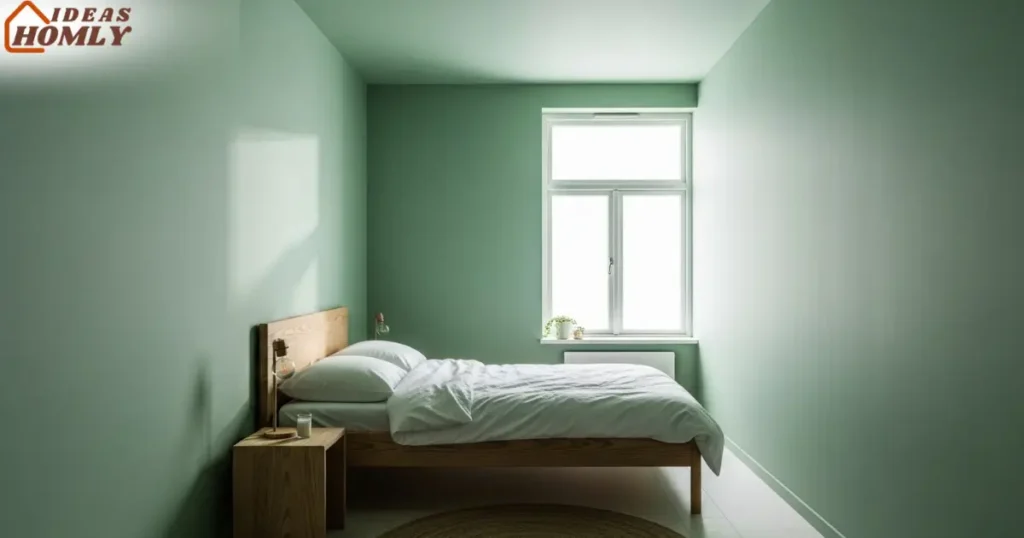
I once tried this in a small bedroom, pairing a soft green wall-and-ceiling combo with natural wood furniture. The result felt calm, connected, and surprisingly airy.
It’s a quick project that doesn’t require professional help, making it a budget-friendly choice too.
2. Add Ceiling Wallpaper
Wallpaper isn’t just for walls. Adding it to the ceiling can give your space a unique focal point without adding clutter.
In small rooms, I like using light-colored patterns with subtle texture, like delicate florals, fine geometrics, or tone-on-tone designs. They add personality but won’t overwhelm the space.
One tip I swear by is keeping the pattern scale small. Large, busy prints can make the ceiling feel lower, but small patterns create gentle movement and depth.
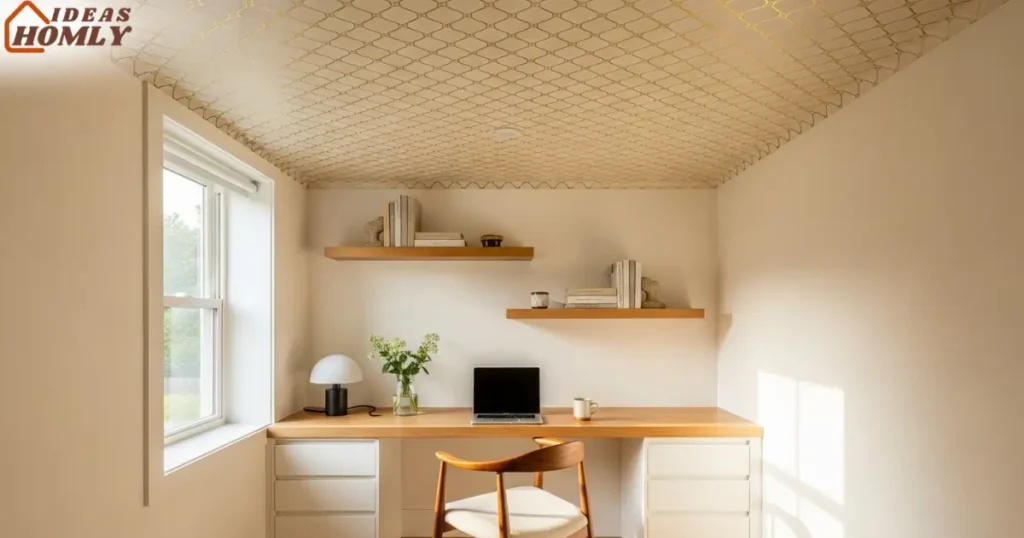
If you have a sloped or awkwardly shaped ceiling, wallpaper can also hide imperfections better than paint.
Last year, I helped a friend cover her home office ceiling with a pale gold geometric wallpaper.
It caught the light beautifully, and she said it made her tiny space feel “finished” in a way plain white never could. Plus, peel-and-stick options mean you can easily switch it up later.
3. Narrow Wood-Slat Ceiling with LED Strip
Adding narrow wooden slats to the ceiling instantly brings warmth and texture to a small room.
I like using slim, evenly spaced slats running in one direction as it draws the eye across the room, creating a sense of length or width depending on the orientation. This effect works well in living rooms, bedrooms, and even small entryways.
To take it up a notch, I often incorporate an LED strip along one or both sides of the slats. The light filters through the gaps, creating a soft glow that makes the ceiling look higher and more dynamic.
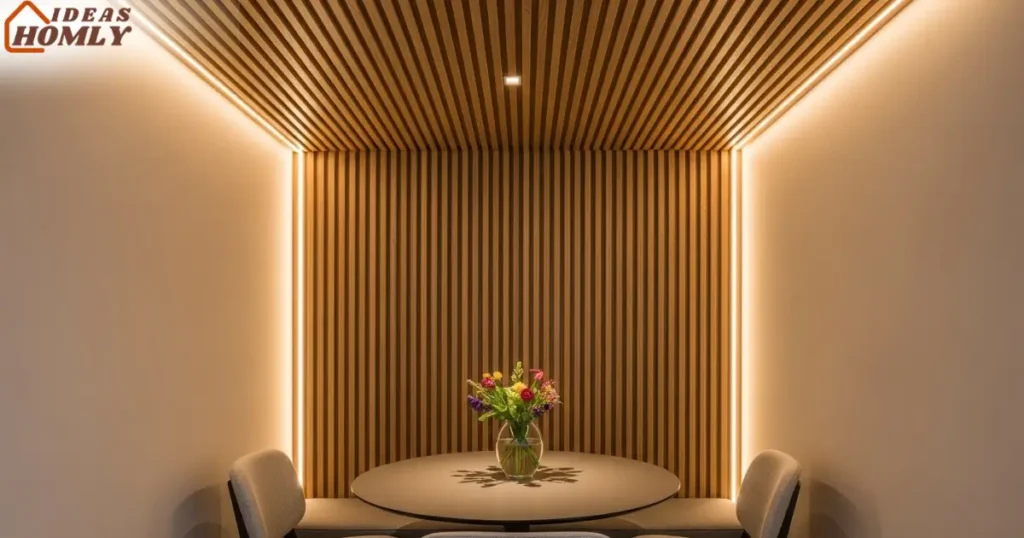
Warm white lighting is my go-to for cozy vibes, while cool white works better for modern, crisp interiors.
When I did this in my dining nook, the slatted ceiling completely changed the mood of the space. It felt richer, more layered, and the glow from the LEDs made evening dinners feel almost restaurant-like without sacrificing that homey comfort.
4. Bold Flush-Mount Lighting
Small spaces often miss out on statement lighting because we’re afraid it will make the room feel crowded. But a bold flush-mount fixture can actually do the opposite, as it draws attention upward and adds character without hanging down too far.
I usually recommend choosing a design that matches your room’s style but still has an element of surprise.
It could be a sculptural metal piece, a drum shade with an interesting texture, or even a fixture with colored glass. In a neutral room, this one choice can become the “wow” factor without cluttering the floor or walls.

One of my favorite examples was in a tiny hallway where I swapped a dull dome light for a brass and frosted-glass flush mount. The difference was instant.
It looked intentional, added a touch of luxury, and guests always commented on it. For small spaces, a bold ceiling light isn’t just functional but it’s a design moment.
5. Ceiling Medallion with Minimal Fixture
Sometimes, the most powerful detail is a quiet one. A ceiling medallion paired with a minimal light fixture adds elegance without taking over the room. I like using this approach when I want to elevate a space but keep the lighting simple.
For small rooms, I usually go for a medallion that’s proportionate to the space, something around 16 to 20 inches in diameter works well.
You can paint it the same color as the ceiling for a seamless look or choose a slightly contrasting shade to highlight the detail.
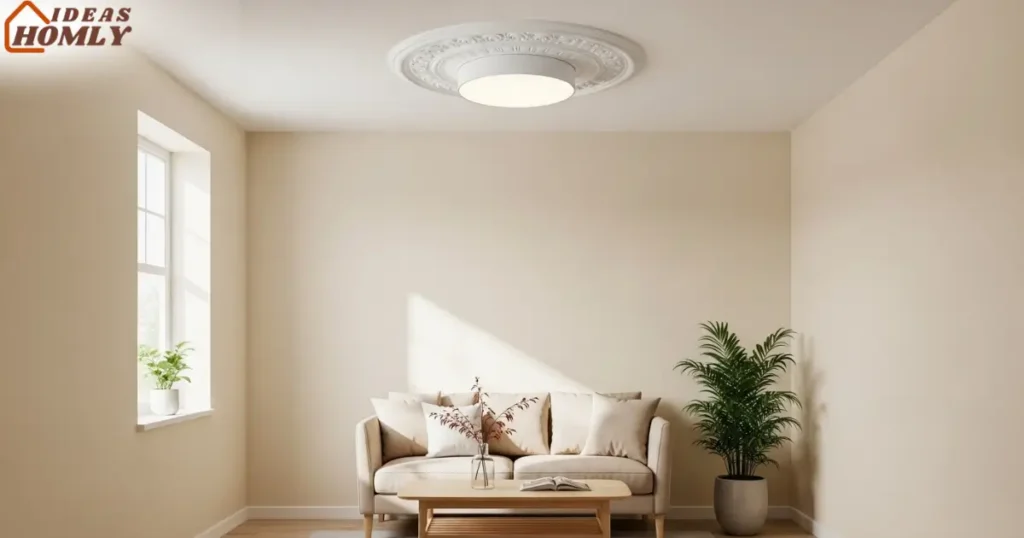
I once added a plain white medallion above a basic flush mount in a studio apartment. The difference was subtle yet impactful; it suddenly looked like a design choice rather than just a light hanging in the middle of the room.
And because medallions are lightweight and affordable, they’re easy to DIY without major tools.
6. Subtle Perimeter Glow Lighting
Perimeter lighting is one of my favorite tricks for making a small space feel bigger. By installing LED strips or concealed lighting along the edges where the walls meet the ceiling, you create a halo effect that visually lifts the ceiling.
Warm, dimmable lighting works best here because it feels cozy and inviting. I often recommend combining this with a clean ceiling surface, either painted or wallpapered, so the glow becomes the highlight.
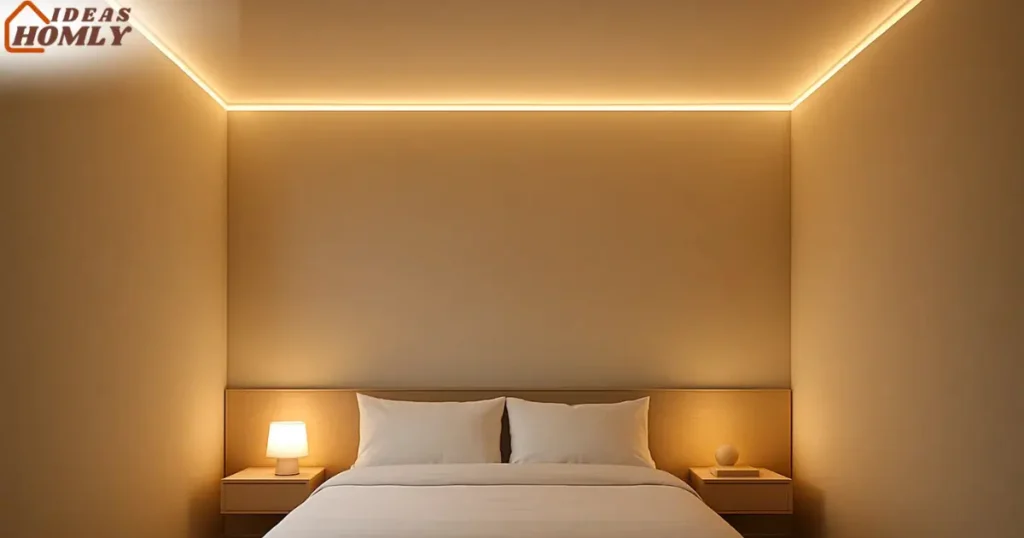
This type of lighting also works wonders in spaces without much natural light, as it eliminates dark corners.
In my own bedroom, I added soft perimeter lighting behind a slim molding. It’s perfect for evenings when I don’t want the overhead light on, and it gives the whole room a calm, hotel-like feel. The best part is that it’s energy-efficient and easy to install, even for renters.
Conclusion
Small spaces have just as much design potential as large ones; you just have to use every surface wisely, and that includes the ceiling.
Whether you choose a seamless wall-and-ceiling paint job, a bold flush-mount light, or subtle perimeter glow, each idea here plays with perception, adds style, and makes your space feel intentional.
I’ve found that the ceiling often becomes the feature people remember most, especially in small rooms where every detail matters.
If you want your home to feel complete, don’t stop at eye level; look up and give that “fifth wall” the attention it deserves.
FAQs
For low ceilings, light shades work best because they reflect more light and create the illusion of height. I prefer warm whites, soft creams, or pale pastels, but you can also use the same color as the walls to create a seamless look.
It depends on the design. Large, busy patterns can make the ceiling feel lower, but small-scale patterns or light tones can add depth without shrinking the space. I always suggest testing a sample before committing.
Not at all. LED lights are energy-efficient, so even if you keep them on for hours, they consume very little electricity. Many come with dimmers and remote controls for extra flexibility.
In small rooms, choose a medallion that’s proportionate to the light fixture and space. Around 16-20 inches works for most rooms under 12 feet wide. Anything too large can overpower the ceiling.
Yes, as long as the styles complement each other. For example, you could pair a painted ceiling with perimeter lighting, or add a medallion to a bold flush mount. Just avoid overloading the design, as balance is key.

